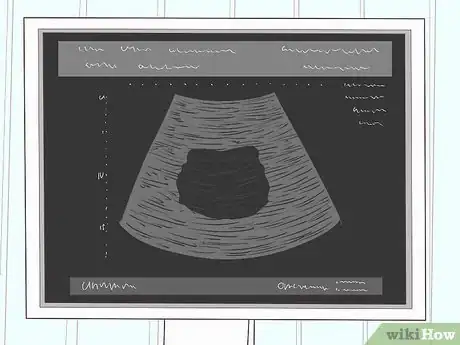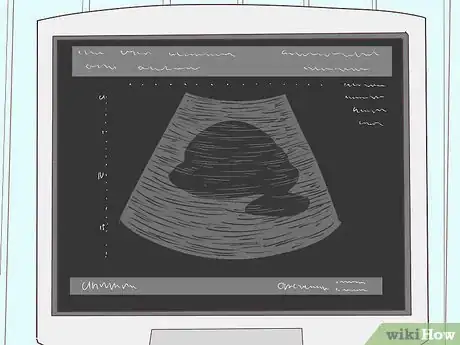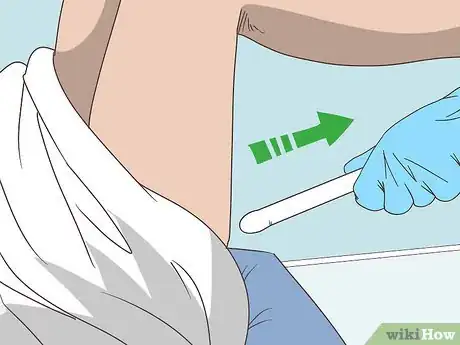This article was medically reviewed by Erik Kramer, DO, MPH and by wikiHow staff writer, Danielle Blinka, MA, MPA. Dr. Erik Kramer is a Board-Certified Primary Care Physician at the University of Colorado. With over 15 years of experience, his clinical interests include obesity and weight management, diabetes care, and preventive care, as well as embracing a holistic approach to primary care. He received his Doctorate in Osteopathic Medicine (D.O.) from the Touro University Nevada College of Osteopathic Medicine and completed his residency at Central Maine Medical Center. Dr. Kramer is a Diplomate of the American Board of Obesity Medicine.
There are 7 references cited in this article, which can be found at the bottom of the page.
This article has been viewed 65,811 times.
Getting an ultrasound may sound scary, but it’s a simple, painless procedure. Your doctor may do an ultrasound to look for problems with your reproductive organs, check for cysts or tumors, find out why you’re having trouble urinating, or monitor your baby’s growth. Both women and men can get pelvic ultrasounds, but it’s more common for women to get them.[1] On the day of your ultrasound, you can eat, drink, and take your medications as your normally would. If you’re getting a transabdominal ultrasound, fill your bladder before the procedure. For a transvaginal ultrasound, empty your bladder.
Steps
Doing General Preparations
-
1Eat your normal meals on the day of your procedure. A full stomach usually won’t affect a pelvic ultrasound, so it’s okay to eat regular meals. You don’t need to change your diet or avoid any particular foods. Go ahead and eat whatever you want.[2]
- It's okay to drink caffeinated products prior to an ultrasound, so you can have coffee, soda, and other caffeinated drinks. It won't cause dehydration or make it harder for you to fill your bladder.
- A pelvic ultrasound is different from an abdominal ultrasound, which does require fasting.
-
2Take all of your medications unless your doctor tells you otherwise. Don’t stop taking your medicine because it typically won’t affect your ultrasound results. Your doctor will tell you if you need to temporarily stop your medication.[3]
- This includes your fluid pills or diuretics.
- If you want to take over-the-counter medication, check with your doctor first.
Advertisement -
3Wear loose clothing that’s easy to remove. The technician will need to access your pelvic area to complete the ultrasound. This means you’ll need to completely or partially remove your clothing. Pick pieces that are easy to remove or pull aside.[4]
- For instance, you might wear a loose dress or a baggy shirt with stretch pants.
-
4Change into a hospital gown before your ultrasound, if required. Your doctor or technician may ask you to change into a hospital gown to make it easier to do your ultrasound. If this happens, remove your clothing and put on the hospital gown.[5]
Variation: Your technician may let your keep your clothes on if you can remove them from your pelvic area. For instance, you may be able to lift your top and push your pants down to your hips.
-
5Take off any jewelry that you’re wearing. Your technician will likely tell you to remove all of your jewelry to make sure it doesn’t interfere with the ultrasound. It’s best to leave your jewelry at home. If you do wear any, remove it and put it in a safe place, like your purse or wallet.[6]
- You will definitely need to remove a belly ring if you have one.
-
6Check with your doctor for specific recommendations. It’s likely that your doctor will just recommend filling or emptying your bladder before the exam. However, they may give you more specific instructions depending on your unique needs. Talk to your doctor at least 24 hours before your ultrasound to find out if they have special instructions.[7]
- For instance, your doctor may ask you not to eat right before your exam. However, this isn’t usually necessary.
Getting a Transabdominal Ultrasound
-
1Drink 4 to 6 cups (0.95 to 1.42 L) of fluids 1 hour before your ultrasound. Your bladder needs to be full in order for the doctor to see your organs. Use the restroom before you start drinking fluids so you start with an empty bladder. Then, drink at least 4 cups (0.95 L) of any fluids about an hour before the exam. You may need to drink more if your bladder fills slowly.[8]
- If you don’t need to urinate very often, you may have a slow filling bladder, which means you should drink more.
- It’s best to relieve your bladder before you fill it up so that you don’t have a restroom emergency before you get your ultrasound.
- When your bladder is full, it pushes your intestines aside so it’s easier to view your abdomen.
Tip: Don’t worry about not having a full bladder. If you’re having trouble maintaining a full bladder, your doctor will insert a catheter to fill your bladder quickly.[9]
-
2Make sure that your bladder doesn’t feel painfully full. You will likely feel some discomfort from your full bladder, and you should feel the urge to relieve yourself. However, you shouldn’t be in pain. If you are, go ahead and relieve your bladder. Then, try to fill it up again but drink less this time.[10]
- It’s okay to start refilling your bladder shortly before your ultrasound. If for some reason your bladder isn’t full when it’s time for your ultrasound, your doctor or the technician will give you some water.[11]
-
3Lie on the exam table and try to get comfortable. You will need to stay still during your ultrasound, so adjust your body to find a comfortable position. Use the pillow that the office provides to cushion your head and neck. This will help you avoid discomfort during your ultrasound.[12]
- If you move around during the ultrasound, the results may not be clear.
-
4Let the technician put gel on your abdomen and slide a wand over it. You might feel a cold sensation as the technician applies the gel over your lower abdomen. Relax as the tech slides the transducer wand over your abdomen, which won't hurt at all. You may feel a little discomfort from needing to urinate.[13]
- You might hear a whoosh sound during the ultrasound, depending on what type of machine the tech is using.
-
5Watch the ultrasound screen to see visuals of your pelvic area. Your tech may let you see the images as they do your ultrasound, especially if you're pregnant. If you want to watch, look at the screen that's attached to the ultrasound screen. The images will be in black and white and may be hard to decipher.[14]
- The tech or your doctor will explain the images for you if you don't understand them.
-
6Let the tech clean the gel off of your abdomen after the ultrasound. After your ultrasound is finished, the tech will use a towel to wipe the gel off your lower abdomen. This will prevent it from getting on your clothing.[15]
- If you feel like there's still gel on your abdomen, ask for an extra towel so you can wipe your belly again when you go to get dressed.
- Expect your ultrasound to take about 30 minutes.[16]
-
7Empty your bladder after your ultrasound is finished. Hold your bladder until the technician finishes your ultrasound. When they say it’s okay, go the restroom to relieve yourself.[17]
- Your doctor may do a transvaginal ultrasound after you empty your bladder to get a better view of your uterus and ovaries. If this is the case, you’ll return to the exam room after you empty your bladder. Otherwise, it’s okay to get dressed.
-
8Get dressed and continue your day as normal. Change back into your clothes once the ultrasound is finished. You don’t need to do anything special after this procedure, so it’s okay to resume your normal activities.[18]
- Your doctor will discuss your results with you either at this appointment or at a follow up appointment. Talk to your doctor to find out if you need to come back.
Having a Transvaginal Ultrasound
-
1Empty your bladder right before your ultrasound. Visit the restroom at the start of your doctor’s appointment or while you’re changing into the exam gown. Your bladder needs to be completely empty during a transvaginal ultrasound so that your bladder doesn’t block the view of your organs.[19]
- If you feel like you need to use the restroom at any point during the exam, tell your doctor or the ultrasound technician.
- If you’re having both a pelvic ultrasound and a transvaginal ultrasound, your doctor may tell you to arrive with a full bladder and wait until after your pelvic ultrasound to empty it.
-
2Lie on the exam table and put your feet in the stirrups. For a transvaginal ultrasound, your feet and legs are supported by stirrups that are attached to your exam table. This will keep you as comfortable as possible while your legs are spread for the ultrasound. Climb up on the table and get into a comfortable position. Then, lie back and put your feet into the stirrups.[20]
- If you’re having trouble getting your feet positioned correctly, ask a nurse or the technician for help.
-
3Relax your pelvic muscles as the technician inserts the transducer. Take slow, deep breaths to help you relax your body, which will minimize your discomfort. The ultrasound tech will cover the transvaginal transducer in a plastic or latex sheath and will lubricate it. Then, they’ll slide the tip of the transducer into your vagina. Try to stay relaxed as they maneuver the transducer into place.[21]
- The technician may turn the transducer to get a better view of your pelvic area.
- You may experience some discomfort during the exam, but it shouldn’t be painful.
-
4Watch the ultrasound monitor if you want to see the images. You may be able to view the ultrasound images on a monitor that's attached to the ultrasound machine. The images will be in black and white, and they may look very blurry. The tech or your doctor will explain the images to you.[22]
- Your tech may turn the screen away from you. If they do, you'll still be able to look at the images later. Try not to worry because they may do this so they can get a better look as they maneuver the transducer.
-
5Keep your pelvic muscles relaxed while the tech removes the transducer. When the tech is finished with your ultrasound, they'll gently remove the transducer. You shouldn't feel any pain, but it can cause some discomfort. Take deep breaths to relax your body, which can help minimize your discomfort.[23]
- Your ultrasound should take about 15 to 30 minutes.[24]
-
6Change back into your clothes and continue your day normally. Get dressed after your procedure is over. Then, resume your normal daily activities. You don’t need any special care after a transvaginal ultrasound.[25]
- Your doctor will talk to you about your results either at the end of your appointment or at a follow up. Ask your doctor when your results will be available.
Warnings
- Your doctor may not be able to get a clear ultrasound image if you’re carrying a lot of extra weight on your abdomen, you have excess gas, your bladder isn’t full during a transabdominal ultrasound, or you’ve recently had a barium procedure.[28]⧼thumbs_response⧽
- If you're suffering from a bladder infection on the day of your ultrasound, try to postpone it because you may experience a lot of pain when you try to fill your bladder.[29]⧼thumbs_response⧽
- If you’re a man, your doctor may not be able to get a clear image if your prostate is larger than normal.[30]⧼thumbs_response⧽
- Inform your doctor if you’re allergic to latex because the doctor or ultrasound technician will likely wear latex gloves while they examine you. If you’re allergic to latex, they can use latex-free gloves, instead.[31]⧼thumbs_response⧽
References
- ↑ https://familydoctor.org/pelvic-ultrasound/
- ↑ https://www.atriushealth.org/specialties-and-services/imaging-and-radiology-services/ultrasound/preparing-for-an-ultrasound
- ↑ https://www.atriushealth.org/specialties-and-services/imaging-and-radiology-services/ultrasound/preparing-for-an-ultrasound
- ↑ https://www.mayoclinic.org/tests-procedures/ultrasound/about/pac-20395177
- ↑ https://familydoctor.org/pelvic-ultrasound/
- ↑ https://www.mayoclinic.org/tests-procedures/ultrasound/about/pac-20395177
- ↑ https://www.mayoclinic.org/tests-procedures/ultrasound/about/pac-20395177
- ↑ https://www.hopkinsmedicine.org/health/treatment-tests-and-therapies/pelvic-ultrasound
- ↑ https://myhealth.alberta.ca/Health/aftercareinformation/pages/conditions.aspx?hwid=abo2689
- ↑ https://www.mayoclinic.org/tests-procedures/ultrasound/about/pac-20395177
- ↑ https://youngwomenshealth.org/2013/02/12/pelvic-ultrasound/
- ↑ https://www.hopkinsmedicine.org/health/treatment-tests-and-therapies/pelvic-ultrasound
- ↑ https://www.hopkinsmedicine.org/health/treatment-tests-and-therapies/pelvic-ultrasound
- ↑ https://www.hopkinsmedicine.org/health/treatment-tests-and-therapies/pelvic-ultrasound
- ↑ https://www.hopkinsmedicine.org/health/treatment-tests-and-therapies/pelvic-ultrasound
- ↑ https://myhealth.alberta.ca/Health/aftercareinformation/pages/conditions.aspx?hwid=abo2689
- ↑ https://www.hopkinsmedicine.org/health/treatment-tests-and-therapies/pelvic-ultrasound
- ↑ https://www.hopkinsmedicine.org/health/treatment-tests-and-therapies/pelvic-ultrasound
- ↑ https://www.hopkinsmedicine.org/health/treatment-tests-and-therapies/pelvic-ultrasound
- ↑ https://www.hopkinsmedicine.org/health/treatment-tests-and-therapies/pelvic-ultrasound
- ↑ https://www.hopkinsmedicine.org/health/treatment-tests-and-therapies/pelvic-ultrasound
- ↑ https://www.hopkinsmedicine.org/health/treatment-tests-and-therapies/pelvic-ultrasound
- ↑ https://www.hopkinsmedicine.org/health/treatment-tests-and-therapies/pelvic-ultrasound
- ↑ https://myhealth.alberta.ca/Health/aftercareinformation/pages/conditions.aspx?hwid=abo2689
- ↑ https://www.hopkinsmedicine.org/health/treatment-tests-and-therapies/pelvic-ultrasound
- ↑ https://familydoctor.org/pelvic-ultrasound/
- ↑ https://www.hopkinsmedicine.org/health/treatment-tests-and-therapies/pelvic-ultrasound
- ↑ https://www.hopkinsmedicine.org/health/treatment-tests-and-therapies/pelvic-ultrasound
- ↑ https://www.mayoclinic.org/diseases-conditions/interstitial-cystitis/symptoms-causes/syc-20354357
- ↑ https://familydoctor.org/pelvic-ultrasound/
- ↑ https://familydoctor.org/pelvic-ultrasound/
About This Article
Getting a pelvic ultrasound is a simple and painless procedure, but there are a few things you need to remember. Wear loose clothes that can be easily removed to your appointment. Avoid wearing jewelry, since you'll need to remove it for the scan. If you’re going for a transabdominal ultrasound, you’ll need to go to the toilet, then drink 5 cups of water 1 hour before your appointment. This will inflate your bladder and push your intestines aside so they’re easier to see on your ultrasound. If you’re going for a transvaginal ultrasound, use the restroom when you get to the hospital so your bladder doesn’t block the view of your organs. To learn what happens during your ultrasound and other tips from our Medical co-author, read on!
















































































Medical Disclaimer
The content of this article is not intended to be a substitute for professional medical advice, examination, diagnosis, or treatment. You should always contact your doctor or other qualified healthcare professional before starting, changing, or stopping any kind of health treatment.
Read More...